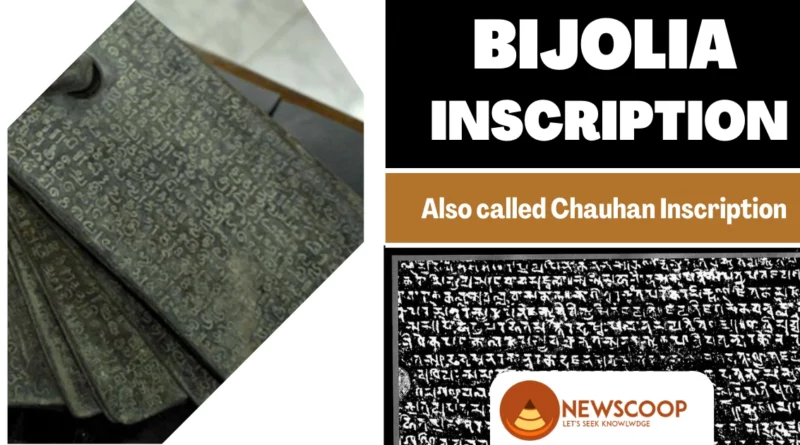Bijolia Inscription [1170 AD]: Chauhan Inscription
In the vast annals of Indian history, certain relics transcend time, preserving the tales of mighty empires and the legacies they left behind. One such remarkable artifact is the Bijolia Inscription, also known as the Chauhan Inscription, dating back to 1170 AD. Carved in Sanskrit, this inscription holds a treasure trove of historical information about the illustrious Chauhan rulers and their contributions. Join us as we explore the fascinating Bijolia Inscription and unravel the captivating narrative it presents.
Bijolia Inscription
The Bijolia Inscription stands as an enduring testament to the past, etched onto a large rock north of a water reservoir in the Bijolia temple complex. This inscription showcases the achievements of the Chauhan dynasty, one of the most prominent ruling houses of medieval Rajasthan. Its location near the Parshvanath temple highlights its connection to Jainism, as it pays homage to the Tirthankar Parshvanath, commissioned by a Digambar Jain named Lolak.
Insights into Chauhan Rulers
The Bijolia Inscription offers a valuable account of the Chauhan rulers, particularly the Shakambari and Ajmer lineages. It provides a comprehensive list of the Chauhan rulers, shedding light on their reigns and contributions to the region. This inscription serves as a crucial historical source, corroborating details found in other texts like the Prithviraja-Vijaya.
Among the early Chauhan rulers mentioned in the Bijolia Inscription, Samat emerges as an intriguing figure. Described as a vipra or brahmin belonging to the Vatsa lineage, Samat signifies the close association between the Chauhan rulers and their Brahminical connections. This highlights the complex socio-political dynamics prevalent during that period and provides insights into the Chauhan rulers’ religious affiliations.
Bijolia Inscription Relaed to Prithviraja-Vijaya
The Bijolia Inscription aligns with the accounts found in the Prithviraja-Vijaya, a famous epic poem celebrating the life and valor of Prithviraja III, one of the most celebrated Chauhan rulers. The inscription serves as an additional source that supports and enriches our understanding of Prithviraja III’s reign, military exploits, and cultural patronage.
Preserving History, Inspiring Research
The preservation and study of the Bijolia Inscription are of paramount importance in unraveling the historical nuances of the Chauhan dynasty. Scholars and researchers must continue their efforts to decipher and interpret the Sanskrit text, unlocking new dimensions of understanding regarding medieval Rajasthan and the Chauhan rulers’ influence.
Also Read: Doobi Copper Plate Inscription
Chauhan Legacy
- The Bijolia Inscription provides a glimpse into the remarkable legacy of the Chauhan dynasty.
- It offers valuable insights into the rulers, their achievements, and their impact on medieval Rajasthan.
- The inscription lists the Chauhan rulers of the Shakambari and Ajmer lineages, showcasing their significance in the region’s history.
- It highlights the close association between the Chauhan rulers and Jainism, as it pays homage to Tirthankar Parshvanath.
- The inscription’s correlation with the Prithviraja-Vijaya epic poem enriches our understanding of Prithviraja III’s reign and cultural patronage.
- Samat, described as a vipra of the Vatsa lineage, exemplifies the complex socio-political dynamics of the Chauhan era.
- Preserving and studying the Bijolia Inscription allows us to honor the Chauhan legacy and uncover further insights into medieval Rajasthan.
- It serves as a link to our shared heritage, connecting us with the brave rulers who shaped the course of history.
- By embracing our history, we can gain a deeper understanding of our roots and pave the way for a brighter future.
Conclusion
In conclusion, the Bijolia Inscription offers us a captivating glimpse into the Chauhan dynasty and the medieval history of Rajasthan. Its simple yet profound words reveal the rulers, their religious affiliations, and their impact on the region. Preserving and studying this valuable artifact allows us to honor the past and connect with our shared heritage, fostering a deeper understanding of the civilizations that shaped our world.
Thank You!

